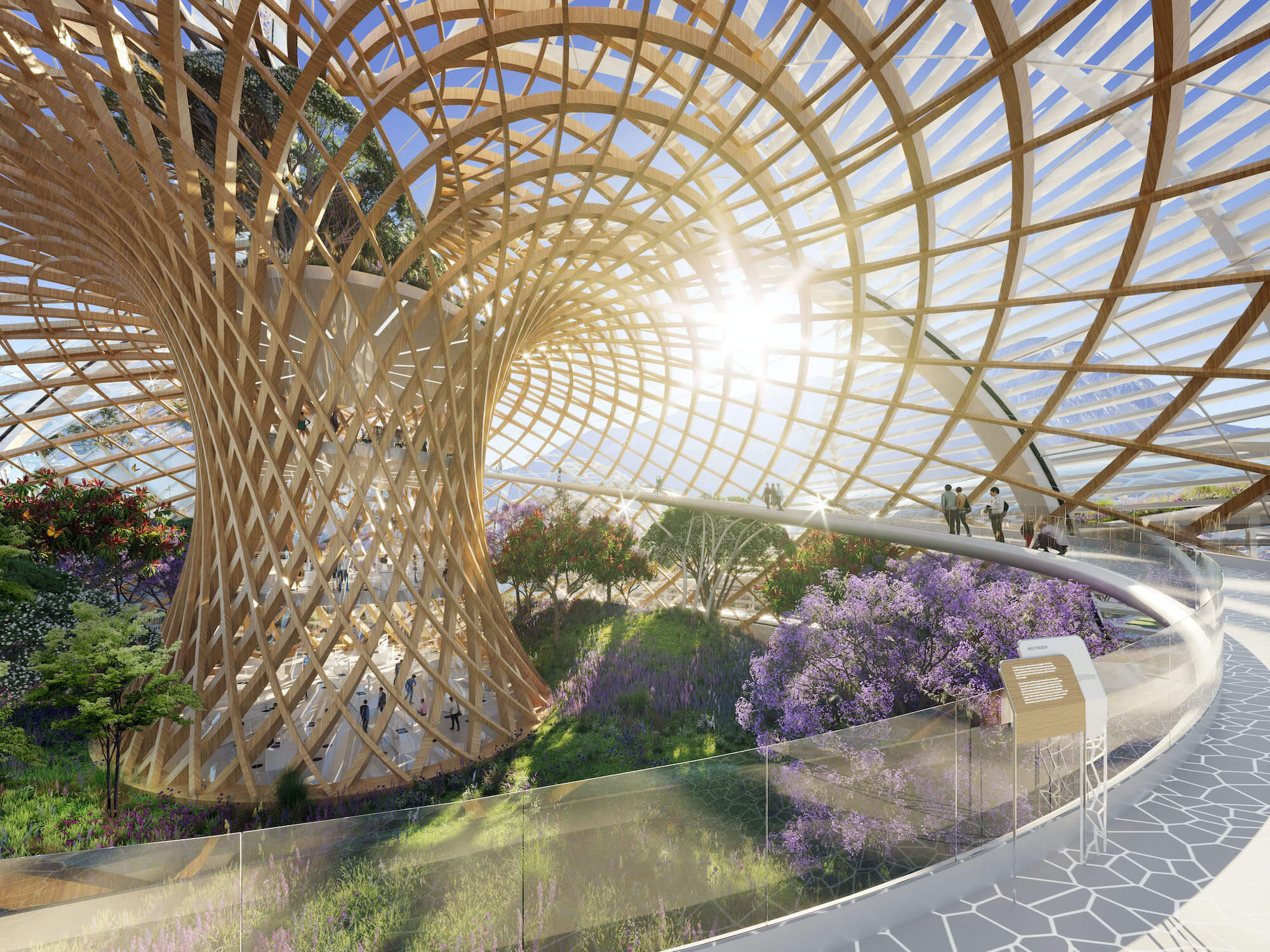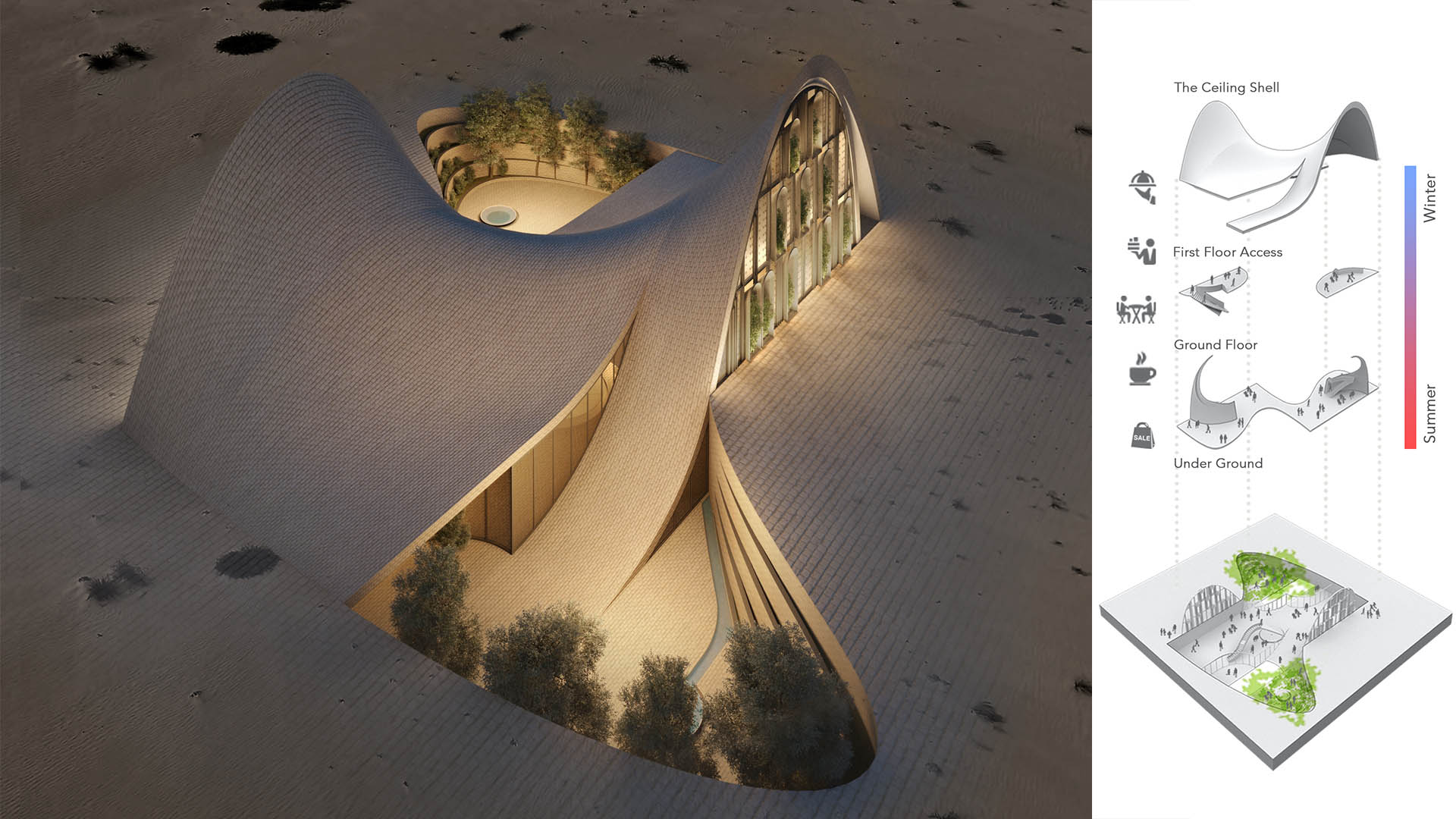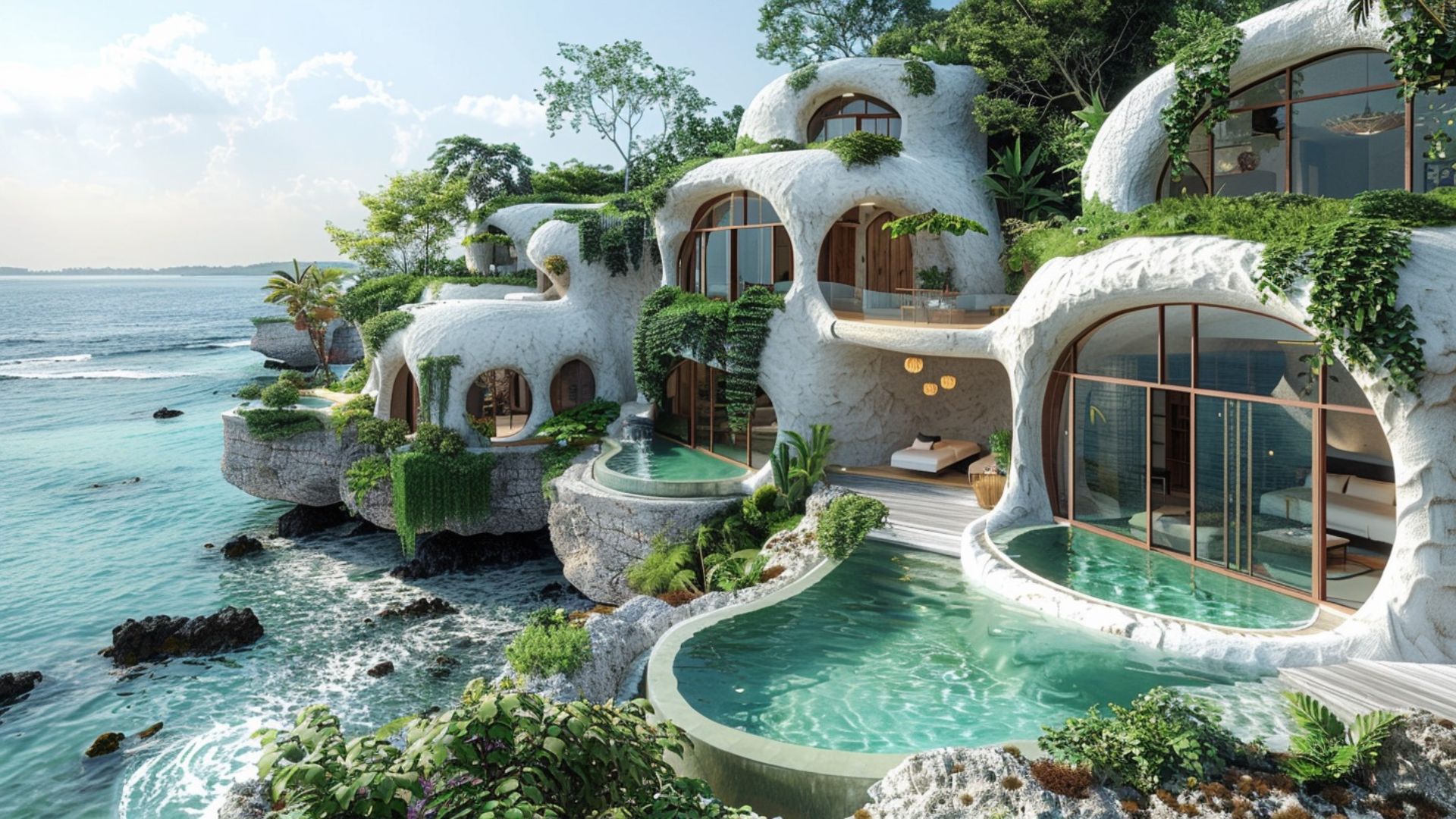The Future of Agriculture and Biodiversity
The European Commission's Pollinator Park offers a mesmerising glimpse into the bleak future without pollinating insects, and a powerful wake-up call to humanity to repair its broken bond with nature. Designed in collaboration with the world renowned ‘Archiobiotect’ Vincent Callebaut, this 30-minute interactive and emotionally engaging virtual reality experience immerses you in a futuristic world where man and nature co-exist in harmony, hoping to change your perspective and help turn the tide of pollinator decline. Conceived as part of the ‘EU Pollinators Initiative’, Pollinator Park should raise awareness, engage society at large and promote collaboration on wild pollinators. It helps ongoing ‘European Green Deal’ efforts to address the nature and pollinator crises, and should also help mobilize support for an ambitious deal for nature at the Fifteenth meeting of the ‘Conference of the Parties to the Convention on Biological Diversity’ (CoP 15) later this year 2021. In particular, members of the EU’s Global Coalition “United for Biodiversity” are invited to use Pollinator Park as part of their own campaigns around biodiversity loss. Check it out here !
ARCHITECTURAL NOTICE, by Vincent Callebaut Architectures
OBJECTIVES: Protect ecosystems in order to halt the decline of pollinators
Bees, bumblebees, butterflies, ants, hummingbirds, bats, ladybugs, beetles. A pollinator is an animal which, while moving around, carries pollen grains from the male anthers to the female stigma of flowers. In doing so, it contributes to the fertilization of the female gametes in the flowerovum as the pollen grains allow plants to reproduce.
The amount and diversity of pollinators strongly influence plant biodiversity and vice versa. The loss of biodiversity in pollinators now threatens the sustainability of the plant communities that feed us.

Endangered by green chemistry and the toxicity of plant protection products, a large part of pollinator populations are victims of a demographic collapse which affects this ecosystem service, which is considered to be major and precious for the global human diet: pollination, in the field of agriculture, animal husbandry, and even forestry.
As of 2020, pollinators are seriously threatened with an extinction rate that is "100 to 1,000 times higher than normal", according to the UN.
The reproduction of more than 90% of the world's species of flowering plants depends on these pollinating animals which have suffered the destruction of their natural habitats, the loss of resources, the explosion of pesticides, and the climatic disturbance that is shifting the seasons. All this due to human activity.

In 1999, more than 20 years ago, during the Convention on Biological Diversity (Declaration on Pollinators, São Paulo), the UN States had already recognized pollinators as “key species” providing ecosystem services necessary to humans as they helped maintain biodiversity, agricultural productivity, and the human economy.
Most of the world's agriculture therefore depends on pollinators. Insects are often considered to be of little importance or even as harmful or troublesome species to be eliminated. And yet, 35% of what we eat depends on pollination by insects including coffee, cocoa, and spices. The service provided by bees and main pollinators has been estimated by INRA at 153 billion euros per year. According to a report published in "Nature" in 2016, the extinction of pollinators threatens 1.4 billion jobs worldwide: 1/5 of the population.
In early June 2018, the European Commission proposed "the very first European Union (EU) initiative to halt the decline of wild pollinating insects", which is based on monitoring and coordination of actions aimed at "remedying the social and economic consequences of the decrease in pollinating insects". Raising awareness among children and European citizens of measures to tackle this decline is the major objective of Pollinator Park.

SOLUTIONS: Pollinator Park, an oasis of sustainable food production with pollinators as the main source
In order to preserve and restore the biodiversity of pollinating fauna, Pollinator Park is a true demonstrator on a real scale. From the Miro's Meadow to the Hungry Hive, via the Urban Lab and the Zoom Room, it promotes the noble role of the farming profession. It shows good practices in pollinator preservation on multiple levels: territorial land-use, agricultural, forest, and urban.
The solutions are numerous and often simple to implement:
1. Territorialization which preserves ecological corridors: restoration of forest edges, fallow fields, pastures, and melliferous meadows, as well as the preservation of multi-layer herbaceous hedges with tall trees and native vegetation along agricultural fields and country roads;
2. Less mono-cultivated, chemical, and toxic agriculture. More reasoned agriculture, prohibiting the spreading of pesticides, fungicides, and insecticides. The agriculture of the future aims at the intensive development of organic farming, permaculture, and agroforestry, three biodiversity-oriented practices;
3. Urbanization fighting against the artificialization of soils: based on the establishment of green and blue networks of natural habitats more favorable to pollinators and the banning of phytosanitary products in public parks and private gardens. This fertile urbanization can be achieved by the establishment of nesting substrates (for example suitable soils, cavities in trees, or building facades) as well as by the deployment of floral resources. These can be increased by creating urban forests, revegetating schoolyards, and building urban farms as well as apartment buildings and green, edible offices covered with vegetable gardens and orchards.

TOOLS: An architectural cluster of biomimetic botanical greenhouses built with mass timber and positive energy
Ecology is the “raw material” of architecture in the 21st century and this is the leitmotif of Pollinator Park. Ode to nature, its organic design is directly bioinspired by pollination, the sexual reproduction method of plants. It thus poetically draws its structure from that of a blooming flower.
Central Park symbolizes female organs and unites all of the park's exhibition spaces. From bottom to top, the ovaries constitute the educational spiral-structured biodomes, the style accommodates a panoramic glass elevator and a Chambord double staircase, while the stigma is transformed into an observation platform flourishing in the sky.
From this epicenter, the Farmlands - biodomes with honeycomb structures, ribbed leaves, or even voronoi - are dedicated to the agriculture of the future. They are spatially organized in a radial plane. Their striated and voluptuous geometries are inspired by anthers, the male organs of a flower covered with pollen grains.

In terms of landscape, these botanical greenhouses for exhibition and agricultural production are protected by a huge perianth. This consists of a 5-sepal calyx around Central Park and a 5-petal corolla around the Farmlands.
The organic architecture of Pollinator Park stimulates the natural flow of the visitor experience where biomorphic architecture and lush nature merge into a unique ecosystem exhibiting how nature creates ecosystems. In each environment, pollinator hotels are integrated into the playful architecture because Pollinator Park is, first and foremost, their home!
Ode to the circular economy and renewable energies, all greenhouses are designed from light frames in cross-laminated timber (CLT) and recycled or recyclable biosourced materials distributed in virtuous loops and short circuits.

The mass timber biodomes are covered with photovoltaic and thermal solar shields in order to become positive energy buildings producing more energy than they consume. These sun shields filter the sun's rays and create a perfect balance between light and shadow.
In order to create this positive balance, a field of wind chimneys and wind turbines is radially implanted in the landscape. This wind farm also makes it possible to use the energy of the wind and take advantage of the ground's thermal inertia to naturally bioclimatize the spaces inside the greenhouses. In fact, the wind chimneys use geothermal energy to cool the greenhouses in summer and heat them in winter, the temperature of the ground resting at 18 degrees Celsius all year round.
In terms of construction and energy, Pollinator Park is therefore a real carbon sink and an exemplary project in terms of ecological engineering.
Within this biomimetic oasis inspired by the shapes, structures, and feedback loops of natural ecosystems, the scenographic experience focuses on the correlation between pollinators and food production. This immersive scenography aims to sensitize and poetically move Europeans, young and old, to better teach them how to protect their natural fauna and flora heritage and consequently their health.

Q&A ABOUT THE COLLABORATION BETWEEN EUROPEAN COMMISSION AND VINCENT CALLEBAUT ARCHITECTURES, by European Commission
1. Why do you want to collaborate with Vincent Callebaut on this project?
EU : The European Commission has already successfully collaborated with Vincent Callebaut in 2018 at the EU Green Week “Green Cities for a Greener Future“, where he was a keynote speaker.
When we started developing Pollinator Park – a virtual universe set in the future, we could not help noticing that the designs are inspired by real-life architectural creations of Vincent Callebaut.
It was clear to us that having Vincent Callebaut – the global authority on futuristic and sustainable architecture – on board of this project would bring many benefits: increase the quality of the project, amplify its impact and help spread the message of the nature crisis beyond the green bubble.
2. What do you like best about his Pollinator Park design?
EU : First, biomimetism – in Pollinator Park architecture serves nature, and as such offers a vision of how architecture can help heal the broken bond between man and nature.
Second, Vincent Callebaut’s design of Pollinator Park puts into practice a lot of principles promoted by the ‘European Green Deal’. It demonstrates what the city of tomorrow could look like combining circular economy approaches, renewable energy and best agricultural and urban practices aimed at protecting and restoring our ecosystems such as agroecology.
Finally, Pollinator Park design combines aesthetics and sustainability, exploring how to live better in harmony with the planet. This is the spirit of the ‘New European Bauhaus’, an initiative launched by the European Commission to design future ways of living, situated at the crossroads between art, culture, social inclusion, science and technology.
3. What do you think is the role of Vincent Callebaut's architectures in the fight against climate change and protection of biodiversity?
EU : ‘European Green Deal’ is EU’s strategy and plan to address the twin crises of climate change and biodiversity loss. For the ‘European Green Deal’ to become reality, sustainability has to become the norm in every sector. Architecture plays a major role in this, from the way our houses are built, to the ways our cities are planned and designed.
With his visionary designs and real-life sustainable buildings of the future, Vincent Callebaut acts like a trailblazer in the architectural and building sector, and a powerful ambassador for the green transition. In his field he brings the vision of the ‘European Green Deal’ to life – a healthier, post-carbon, nature-positive future.
4. Is there a plan to build Pollinator Park in reality to raise awareness among Europeans in life size?
EU : The beautiful architecture of Pollinator Park would indeed deserve to be materialised in the real world, and not stay only in a fictional virtual reality. While the Commission has no plans in this direction, it would welcome such a project as it could serve as an excellent space for education, exchange and engagement on pollinators – a place to heal our relationship with nature – with a view to build a better future.
We of course hope that we will never have to build a ‘refugee camp for insects’. That would mean that we failed to protect nature and pollinators. In the story, in 2050, Pollinator Park is necessary for growing food and preserving the last remaining pollinating insects in the wake of ecosystem collapse. We hope that this future never comes to be, and Pollinator Park aims to mobilise action now to prevent that future.
In his design of Pollinator Park, architect Vincent Callebaut shows how architecture can also help in the fight for a better future, integrating the best agricultural, technological, and design practices for living in harmony with nature. In that sense, Pollinator Park is a significant contribution to the reflection on the ‘New European Bauhaus Initiative’, possibly offering a blueprint for many projects that will be developed as part of it.





CLIENT: European Commission, Brussels
EU COMMISSIONER ENVIRONMENT: Virginijus Sinkevicius
ARCHITECT: Vincent Callebaut Architectures, Paris
PARTNERS: Royal Belgian Institute of Natural Sciences, Museu de Ciencies Naturals of Barcelona, Naturalis Biodiversity Center of Leiden
STORY & TECHNOLOGY: Poppins & Wayne
VIRTUAL REALITY: Cousteau Studio
PERFORMING: "Dead Beez" by Stiin Cole





